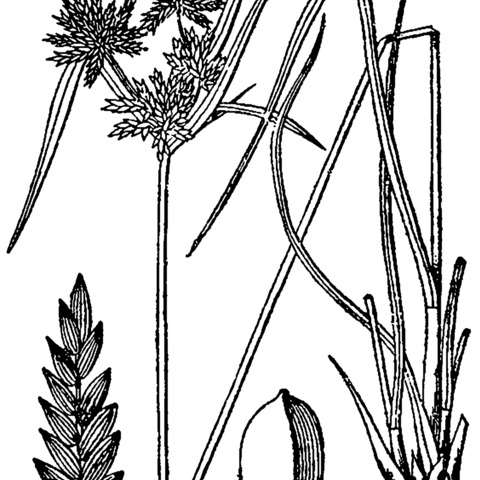Herbs, perennial, cespitose, bases cormose, rhizomatous. Culms trigonous, 5–50 cm × 0.5–1.5 mm, glabrous. Leaves V-shaped, 12–30 cm × 1–6 mm. Inflorescences: spikes ± globose to broadly ovoid, 8–20 mm wide; rays 1–8 cm; rachis 2–5 mm, glabrous; bracts 3–8, weakly ascending, flat, 3–20 cm × 1–3.5 mm; rachilla deciduous, wingless. Spikelets 3–18, compressed, ovoid to oblong-lanceoloid, 4–15 × 2.6–3.4 mm; floral scales deciduous, 3–18, laterally stramineous to reddish brown, laterally 3–4-ribbed, broadly ovate, 1.8–2.5 × 1.3–1.6 mm, apex with mucro 0.1–0.2 mm. Flowers: anthers 0.5–0.7 mm; styles 0.4–0.6 mm; stigmas 1–1.5 mm. Achenes dark brown, sessile, broadly ellipsoid, 1.5–2 × 1–1.5 mm, apex obtuse, apiculate, surface glabrous, puncticulate, or papillose. 2n = 168, 170, 172.
More
Much like no. 25 [Cyperus schweinitzii Torr.]; stems smooth, rather obtusely angled, mostly 0.5–1.5 mm thick below the infl; lvs smooth or scabrous on the margins; invol bracts divergently ascending or ± spreading, scales rotund, 2–2.5 mm, in side-view over half as wide as long, multinerved, obtuse or the uppermost minutely mucronulate; achenes 1.5–2 mm, two-thirds as thick (or a little thicker), trigonous with evidently concave faces; 2n=ca 168–172. Dry, often sandy soil, commonly with Pinus banksiana; Mass., N.H., Vt., and s. Que. to Minn. and nw. Ind.; isolated (as a waif?) in n. Va. and e. W.Va. Thought to be derived by stabilizing selection from hybrids between nos. 25 and 27 [Cyperus lupulinus (Spreng.) Marcks] but the achenes different from both.

